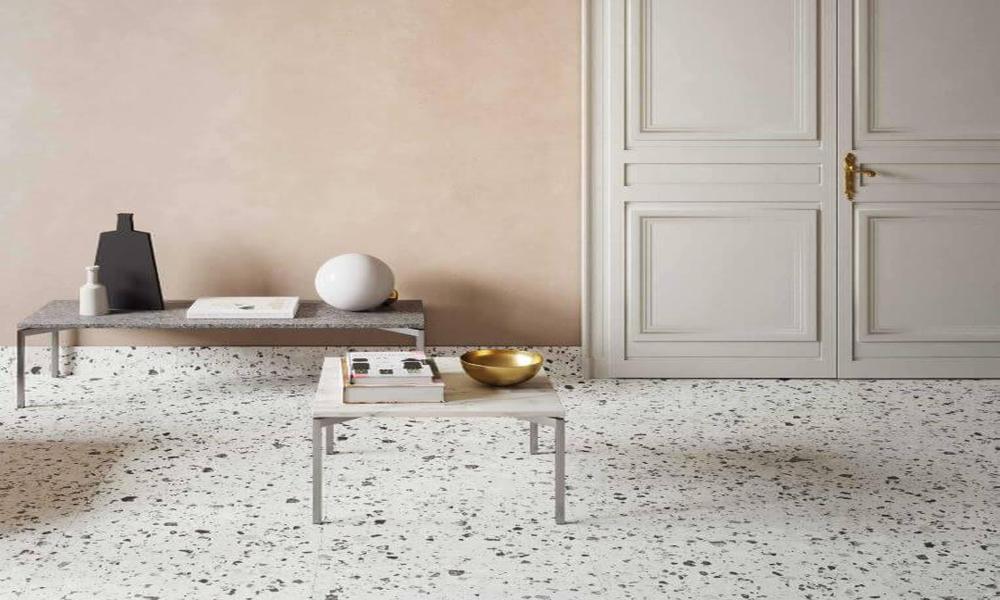Terrazzo flooring originated in Italy over 500 years ago. It was first used by Venetian construction workers as a way to use up scraps of marble that would otherwise go to waste.
The word “terrazzo” comes from the Italian word for “terrace” because the flooring was first used outdoors on terraces.
Terrazzo flooring is made by combining marble or granite chips with a binder, such as cement or epoxy, and then polishing it to a high shine.
Terrazzo is a sustainable flooring option because it uses recycled materials and can last for decades with proper maintenance.
Terrazzo flooring was popularized in the United States in the 1920s and 1930s and was used in many public buildings, such as schools, hospitals, and government buildings.
Terrazzo can be customized with different colors and patterns, making it a versatile design choice for commercial and residential spaces.
Terrazzo is known for its durability and resistance to wear and tear, making it a popular choice for high-traffic areas.
In recent years, terrazzo has made a comeback in interior design and is now being used in trendy restaurants, hotels, and retail spaces.
Terrazzo flooring can also be used in outdoor spaces, such as patios and pool decks, for a stylish and durable finish.
Terrazzo flooring requires regular maintenance, including sealing and polishing, to keep it looking its best.
Misconceptions about TERRAZZO FLOORING
Terrazzo flooring is only suitable for commercial use: While terrazzo flooring was initially popular in commercial settings, it has become increasingly popular in residential homes due to its durability and versatility.
Terrazzo flooring is only available in neutral colors: Terrazzo flooring is available in a wide range of colors and patterns, allowing you to customize it to your liking.
Terrazzo flooring is slippery and dangerous: Modern terrazzo flooring includes anti-slip properties, making it safe to walk on even when wet.
Terrazzo flooring is difficult to clean and maintain: Terrazzo flooring is easy to clean with mild soap and water and can be sealed to prevent staining and damage.
Terrazzo flooring is expensive and unaffordable: While terrazzo flooring can be costly, there are budget-friendly options available that can achieve a similar look.
Terrazzo flooring is only available as a solid surface: Terrazzo flooring can also be created with aggregates, giving it a textured and patterned look.
TERRAZZO FLOORING Mistakes
Inadequate subfloor preparation: Terrazzo is typically installed over a concrete subfloor. If the subfloor is not properly prepared, it can lead to unevenness, cracks, or other issues that can compromise the integrity of the terrazzo.
Poor installation techniques: Terrazzo is typically poured on site, which requires skilled labor and attention to detail. If the installation is rushed or not done properly, it can lead to cracking, unevenness, or other issues.
Incorrect mixing or ratio of materials: The materials used to create terrazzo include a combination of cement, aggregates, and other additives. If the ratio of these materials is off or they are not mixed properly, it can lead to problems with the finished product.
Not sealing the surface: Terrazzo is a porous material that can absorb stains and moisture if not properly sealed. Failing to seal the surface can lead to discoloration, staining, or other issues over time.


 How to Choose the Best Dental Products for Your Needs?
How to Choose the Best Dental Products for Your Needs?  Common Entry Points for Pests in Homes
Common Entry Points for Pests in Homes  Floral Arrangements: Pairing Flower Vases with Artificial Flowers
Floral Arrangements: Pairing Flower Vases with Artificial Flowers  Efficiency Hacks with Material Handling Equipment: Power Up Your Workshop
Efficiency Hacks with Material Handling Equipment: Power Up Your Workshop  Unlock Your Business Potential with the Leading Digital Marketing Agency in Bristol
Unlock Your Business Potential with the Leading Digital Marketing Agency in Bristol  The Ultimate Guide To Vulcan Cladding: Benefits And Applications
The Ultimate Guide To Vulcan Cladding: Benefits And Applications  Beyond the Diamond: Selecting Alternative Gemstones or Opting for No Stone at All
Beyond the Diamond: Selecting Alternative Gemstones or Opting for No Stone at All  7 Unique Tips to Hire the Best Accountant for Your Company
7 Unique Tips to Hire the Best Accountant for Your Company  Discovering The Development of Dating Apps
Discovering The Development of Dating Apps 